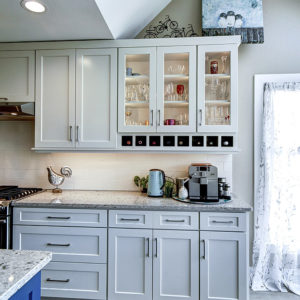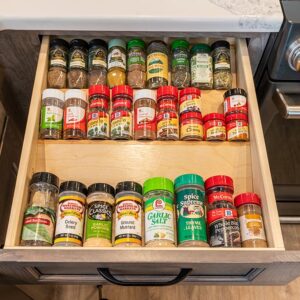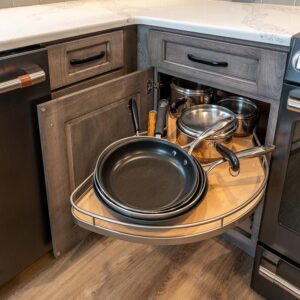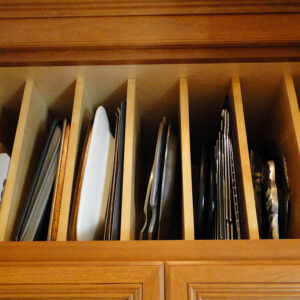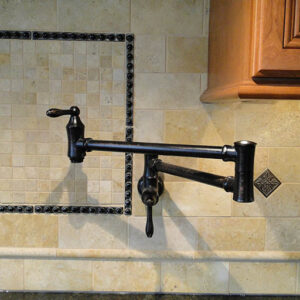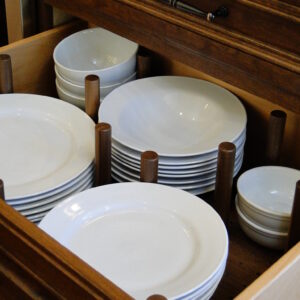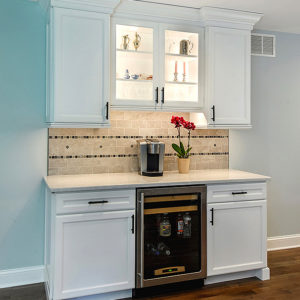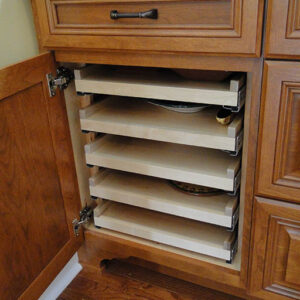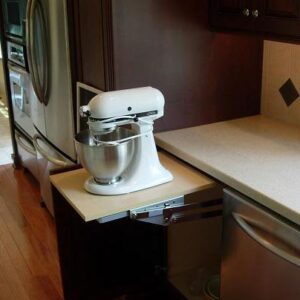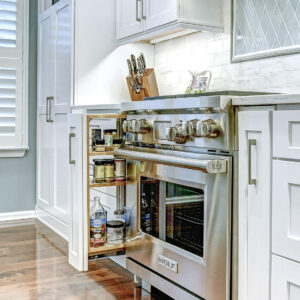 Are you – or someone you know – an “at-home” chef? Great cooking is an artistic expression in its own right. But, despite how skilled you or your loved one may be, your kitchen design can make or break the process, creating either a blissful experience or a massive headache.
Are you – or someone you know – an “at-home” chef? Great cooking is an artistic expression in its own right. But, despite how skilled you or your loved one may be, your kitchen design can make or break the process, creating either a blissful experience or a massive headache.
We’ve had the opportunity to do kitchen redesigns for several cooking enthusiasts, and have found that while the style can vary, there are generally some non-negotiables that all cooking-lover-kitchens should have. In this blog post, we break these down into three core areas:
1) Layout & Storage
2) Appliances & Lighting
3) Materials & Finishes
Whether you’re looking to optimize your kitchen to hone in on your craft, or are just curious about how the pros make it happen seemingly effortlessly, read on!
1) Layout & Storage for Seamless Efficiency
Nail the layout by creating a “working triangle” The layout is critical and serves as the foundation of this space. The “working triangle” theory asserts that your three main work areas (sink, refrigerator, and stove) should form a triangle. Depending on the size of your kitchen, your designer can help you determine adequate distance between each, but generally you want to find a balance – not too far apart, but not too compact either. This will enable comfortable movement and flow between your prep work at the sink, grabbing ingredients from the fridge, and the actual cooking or baking at the oven.
Create convenience by establishing “work zones” We recommend making each point of the triangle and the surrounding areas individual work “zones” – meaning that the different steps of the cooking process, and all of their necessary tools, should be centralized. When you’re working with a kitchen designer, align on the stations that will work best for you as a cook, to ensure that the design and layout accommodates enough storage space and surface area.
Your zones can vary, but these seven are pretty standard:
- Prep zone: Your sink/large counter area that should include your knives, peelers, trashcans, etc.
- Cooking zone: This is your stove/oven area that should include accessible storage space for things like pots, pans, and large utensils.
- Baking zone: This should be near your oven, so consider it the next-door neighbor of the cooking zone. It includes your roll trays, baking sheets, measuring cups, spices, and other must-haves. One nuance is that the more “professional” chefs tend to keep spices and oils away from the stove, as heat damages/weakens them.
 Beverage zone: This can include counter space next to your refrigerator, to enable easy access and pouring of juice, water, coffee, etc, and can also include space for the coffee maker. Ideally your glasses (and coffee grinds/k-cups) will be housed in a nearby cabinet and drawer.
Beverage zone: This can include counter space next to your refrigerator, to enable easy access and pouring of juice, water, coffee, etc, and can also include space for the coffee maker. Ideally your glasses (and coffee grinds/k-cups) will be housed in a nearby cabinet and drawer.- Lunch-packing zone: Dedicate a cabinet or two above or below counter space – ideally within reach of both your snack pantry and prep utensils – for food containers, reusable water bottles, napkins, foil, etc.
- Cleanup zone: Cleanup supplies are typically centralized under or around the sink (next-door neighbor of the prep zone), including cleaning liquids, paper towels, and trash bags. We encourage you to store anything with chemicals out of the reach of children.
- Entertainment zone: A large island is ideal for guests and can be dual-purpose, with one end for snacks and seating, and the other for you or your chef(s) to prepare dishes, while still remaining in close proximity to friends and family. The flow should enable guests to move in and out of the kitchen without disturbing the cook. The cook’s end of the island should be closest to the prep, cooking, and refrigerator zones, while the guests’ end should be closer to the entryway into the living room.
Fit more “stuff” while reducing clutter with creative (and ample) storage spaces
For example
- Pantry systems
- Nook you can put behind your oven for oils
- Spice rack (or a “secret drawer”)
- Peg systems to store plates in drawers
- Spice inserts/pull-outs
- Corner cabinet (lazy susan, leman’s unit, magic corner)
- Special dividers for baking sheets to avoid cramming
2) Appliances & Lighting for Function & Lifestyle
Select appliances based on your lifestyle
Selecting the “right” appliances for your kitchen will vary depending on a few factors. Ask yourself these questions:
- Which appliances do you use most often?
- Which foods do you cook the most?
- Are you a vegetarian? Or do you eat meat or fish often?
- Do you have a large or growing family?
- Do you host guests often?
- Do you shop weekly? Or once or twice a month in bulk?
- Do you use speciality cookware?
The answers to these questions will help you determine the right appliances, including the size and layout of your refrigerator, freezer, and dishwasher, and whether you’d benefit from two small ovens or a single large one, two sinks, etc.
In terms of appliance quality, we find that more advanced cooking enthusiasts will invest in longer-lasting, state-of-the-art stainless steel appliances. Whether your budget limits you to commercial-grade appliances or not, you’ll want to ensure a large ventilation system to accommodate for heat, smoke, and vapor.
Strategically store your appliances
When it comes to the positioning of larger appliances, consider the “work zones” we mentioned before. As for the smaller, countertop appliances (blenders, food processors, mixers, bullets, etc), it’s important to create a home for them. No one wants to travel to the basement or garage to retrieve them, as it creates inefficiency and hinders your workflow. We’ve found that more and more people are looking to keep their frequently used appliances plugged in and ready to use, but want them out of sight. For this, we’ll often build an appliance garage, built on a centralized countertop behind “doors” – making it easily accessible but without clutter.
Alternatively, you could use a large drawer, or store them in a walk-in pantry, if you have one. For heavier items – like a mixer – you can add a moveable stand for it, so you don’t need to lift it (ideal for bakers!).
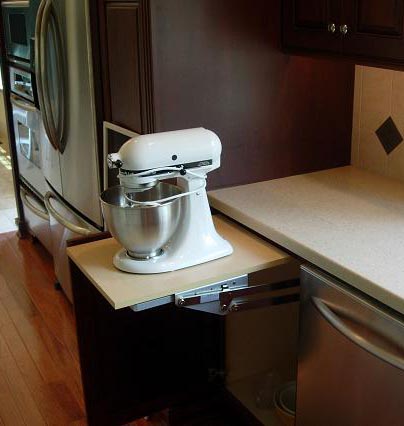
3) Materials & Finishes That Blend Style & Function
Flooring Choose flooring that is comfortable, easy to clean, and fits your style. The obvious choice for most is hardwood, as it’s visually appealing and easy to maintain. However, it all depends on the style of the rest of your kitchen – you want it to match! For example, the material and color of your flooring will vary for modern, vintage, and southern-style kitchens.
Countertops Similarly to appliances, serious chefs will opt for stainless steel to withstand heat and stains, and for easy maintenance. For an eco-friendly option, consider recycled glass countertops (these are also heat-resistant). If style and self-expression are important to you, ceramic tile and porcelain offer a wider variety of colors and enable more creativity, while still maintaining heat and stain-resistance.
Conclusion
Ultimately, your cooking-lovers-kitchen can and should blend function with style, according to your budget. We’d recommend starting with a list of your “must-have” kitchen items, and go from there!
If you’re in need of a kitchen contractor, please contact us! We can have a virtual design meeting, or we can meet at our Design Center (we have several COVID-19 protocols in place, which you can find here). If you’re concerned about budget, let’s chat and we’ll determine what is feasible.
Want to see some of these kitchen remodel ideas in action? Check out our kitchen portfolio page for before and after pictures!

